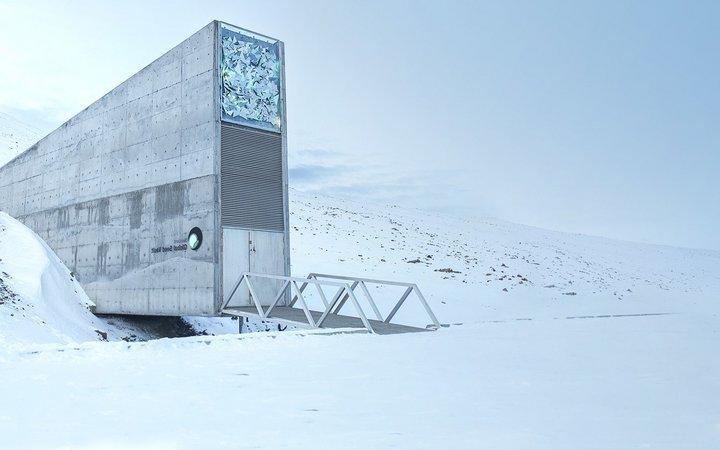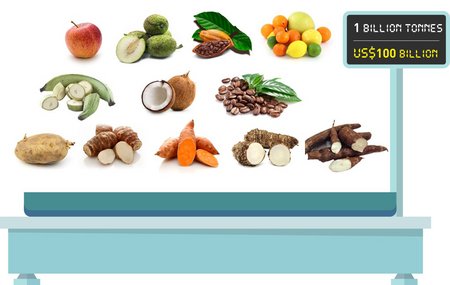On the 10th anniversary of the Svalbard Global Seed Vault, a call for conserving the rest of the world's food

This week Ann Tutwiler was privileged to join the celebration of the 10th anniversary of the Svalbard Global Seed Vault where she presented on why the world also needs a backup collection for crops that cannot be conserved by seed. Read her blog.
This week Ann Tutwiler, Director General, Bioversity International, was privileged to join the celebration of the 10th anniversary of the Svalbard Global Seed Vault. During the event, she presented on why the world also needs a global backup collection for crops that cannot be conserved by seed. Read her blog below to find out why.
Last weekend I was privileged to join the celebration of the 10th anniversary of the Svalbard Global Seed Vault. The Seed Vault is located deep inside a mountain under the permafrost on a remote island in the Svalbard archipelago, halfway between mainland Norway and the North Pole. It is the permanent global fail-safe repository of more than one million seeds from the world’s crops including maize, rice, wheat, barley, and beans.
What I saw, standing outside the Seed Vault, in the freezing wind and sleet, watching dozens of countries reverentially deposit their precious seeds was an affirmation of the trust and the forethought that the guardians of our food security had in creating the Seed Vault.
But, there are many crops that cannot be conserved by seeds. These include banana, cacao, cassava, coconut, coffee, potato and yams. These crops either don’t produce conventional seeds, like bananas, or because the seeds they do produce do not always resemble their parents, like potatoes and many other roots and tubers. This makes it impossible to reproduce them.

These crops account for one billion tonnes of food a year, valued USD$100 billion. Some are critical food security crops for the poor, like cassava and taro; others are important crops for nutrition, like apples and strawberries. Still others are economically important, like garlic and mulberry.
These crops are stored, for the short term, in test-tube plantlets and in field collections that are inherently high risk of neglect, disease, and natural disasters. A few years ago, for example, a coconut collection was bulldozed to make way for a detention facility. Another coconut collection fell victim to urban development.
There is no equivalent to Svalbard for these crops asthere is no global fail-safe collection for vegetatively propagated crops.Fortunately there is a solution — cryopreservation.
Cryopreservation is safe, reliable and dependable. In cryopreservation, plants are stored in liquid nitrogen at a temperature of -196 °C, a temperature so cold that it effectively stops all the living processes within the plant tissue, freezing it forever in time. Plants can then be regenerated from tiny stored samples and grown into whole plants.
Bioversity International, with our partners at Katholieke Universiteit Leuven (KU Leuven), has cryopreserved over 60% of the world’s banana collection in Belgium. Other CGIAR research centers, including the International Center for Tropical Agriculture (CIAT), the International Potato Center (CIP) and the International Institute of Tropical Agriculture (IITA) are also cryopreserving their collections, along with a few national genebanks around the world.

At Svalbard, I presented the results of an independent expert report.* The report concludes that “a major global initiative is urgently needed to accelerate the development and implementation of crop cryopreservation”.
The report points out the need to develop cryopreservation protocols for additional crops. Bioversity International and KU Leuven have already developed necessary protocols for more than 30 crops. But as the report also points out, efficient protocols for some important species are still missing. Other recommendations include that the facility should be accessible as the collection would require constant monitoring of the equipment along with uninterruptible supplies of liquid nitrogen and electricity. Also alongside a global back-up facility, a strong programme of capacity development and training needs to be built.
The report recommends that “a safety back-up cryopreservation facility is set up” and that “the facility should follow the principles and policies that govern the Svalbard Global Seed Vault”.
To complete the conservation circle, we need to establish a task force to evaluate proposals to host the Cryo-Collection, seeking bids from interested parties, assessing possible locations and, seeking commitments from donors.
Norway’s commitment to the Global Seed Vault is exemplary, and worth celebrating. On the 10th anniversary of the Vault, it is time to commit ourselves to safeguarding – through cryopreservation – the 100,000 crop varieties that the experts say could easily be lost forever.
Download: Feasibility study for a safety back-up cryopreservation facility. Independent expert report.
*The report was commissioned by Bioversity International, the International Potato Center (CIP) and the Global Crop Diversity Trust with financial support from Australia, Germany and Switzerland to investigate the feasibility of establishing a safety back-up facility for cryopreserved collections of crops that are vegetatively propagated or have recalcitrant seeds. The independent Expert Group investigated the state of crop cryopreservation in 26 institutes and collated information on field and in vitro collections around the world.
View Ann Tutwiler's presentation: The Case for a Global Cryo-Collection
This research is part of the CGIAR Genebank Platform and the CGIAR Research Program on Roots, Tubers and Bananas and is supported by CGIAR Fund Donors.
